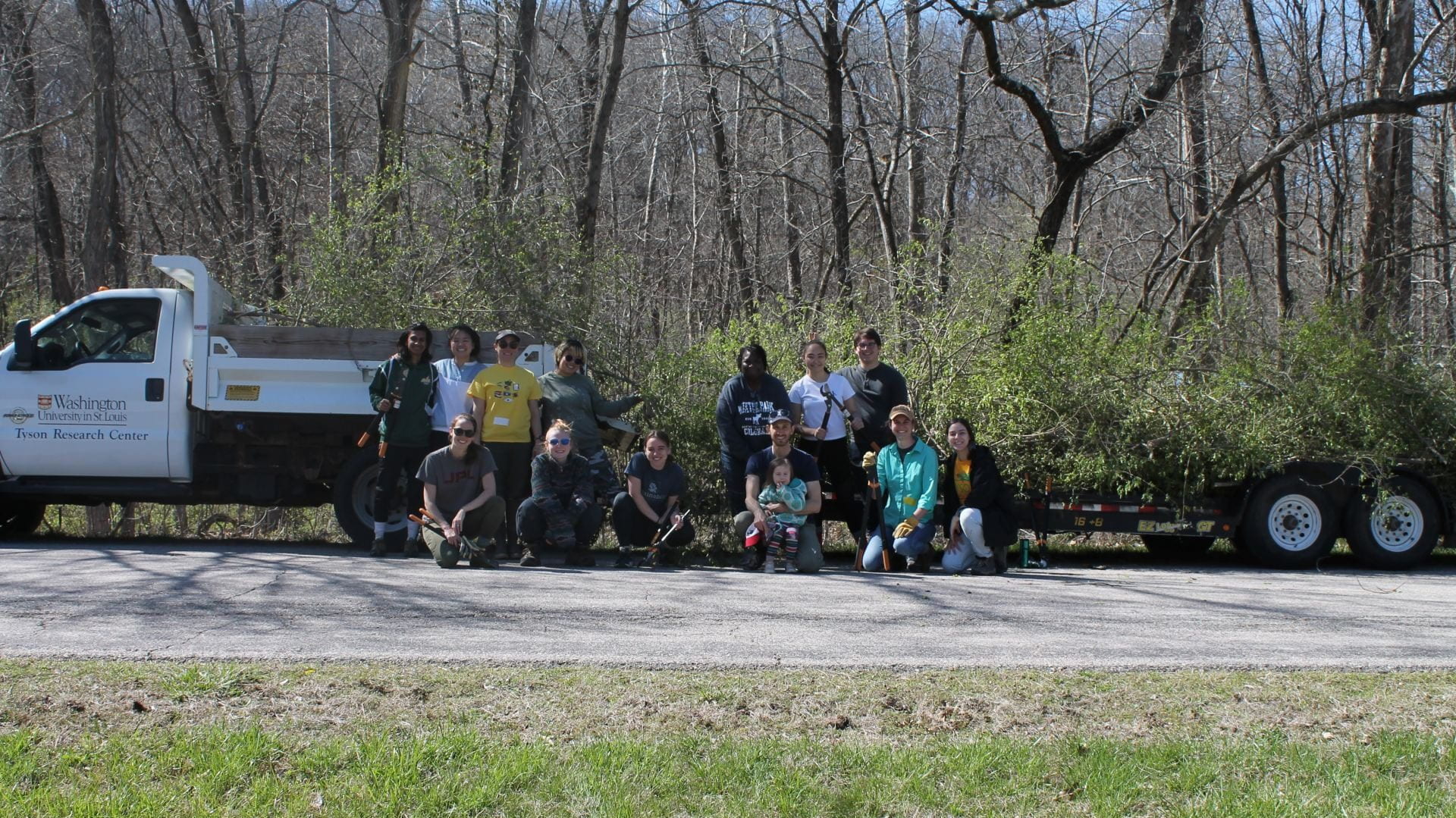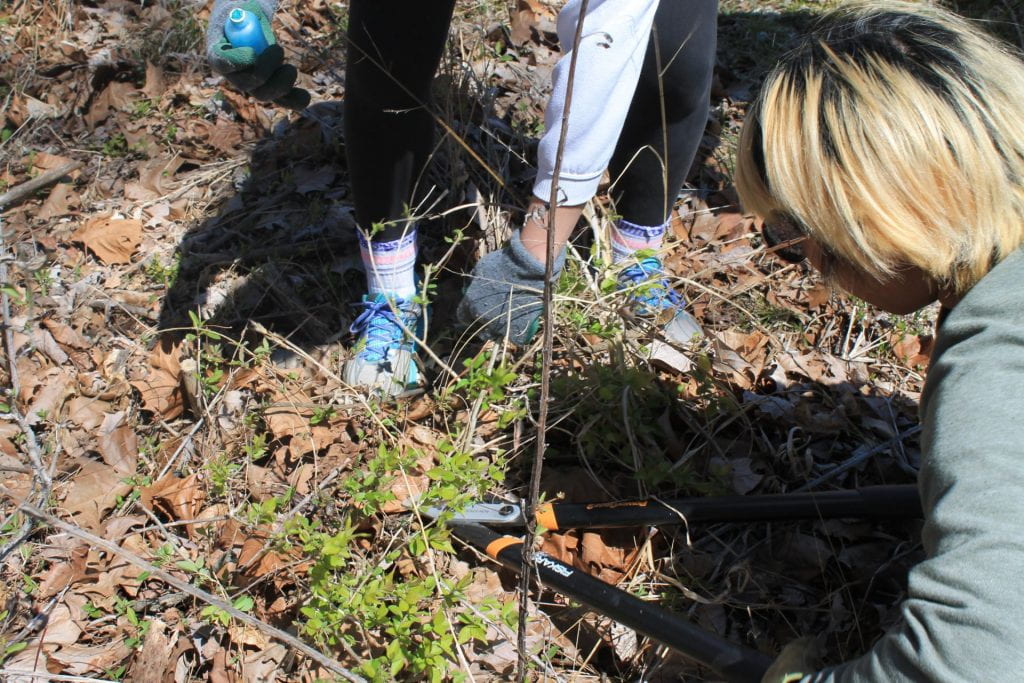This article was written by Jarea Fang, a Communications & Marketing intern at OOS. Along with several other students and staff, they participated in the ESCC Internship’s Spring 2022 volunteering activity, a honeysuckle removal event at Tyson Research Center.
Bush honeysuckle, also known as Amur honeysuckle, is one of the most destructive invasive species in the St. Louis region. Originally imported to North America in the 20th century as an ornamental plant, the bush honeysuckle has since outcompeted many native Missouri plants and tree seedlings. They’re especially infamous for their beautiful red fruits, which are often consumed by birds, but do not provide sufficient nutrients. The iconic Northern Cardinal, for example, is one of the most common Missourian birds to fall victim to the honeysuckle fruits.
Today, residents of Missouri can spot honeysuckle in most urban areas, especially along the side of highways. They are the first thing to start growing leaves in the spring and the last thing to wilt in the fall, which makes early spring and late fall the ideal season for honeysuckle removal. A few weeks ago, the students and staff of the Environment, Sustainability, and Climate Change program (ESCC) did exactly that: the day was Saturday, April 9th, and a dozen of us made the trip over to the Tyson Research Center to identify and remove the bush honeysuckle in the area.
Tyson Research Center is a 2,000-acre outdoor laboratory owned and managed by WashU. Oak-hickory forest covers about 85 percent of the hilly, karst-dominated landscape, which makes Tyson a home to many varieties of trees, ferns, mushrooms, wildflowers, and more. The proximity to Interstate 44, which facilitates the spread of bush honeysuckle, makes its removal a regular activity at Tyson.
“I enjoy teaching people about the ecology of honeysuckle and sharing my knowledge on how removing these species will help the overall health of the forest,” says Beth Biro, the Natural Resources Coordinator and Staff Scientist at Tyson. “I love seeing how people bond over hard work and build community.”
Some students in the ESCC volunteer group, especially those who work with Tyson or are from Missouri, were already familiar with honeysuckle and its removal process. “Remember to wear long pants and high socks you can tuck your pants into,” Mandy Huang, a strategic planning intern at OOS, reminded us a few days before. “If you have duct tape, it will be handy for getting ticks off!”
There were still many of us who didn’t know much about honeysuckle, though. Some of us didn’t even know about the abundance of ticks in the Missouri outdoors until that day.
“I was very excited to see my first tick,” says Samm Kaiser, an engagement specialist at OOS. Still, it was vital that we held fast to our gloves and long-sleeved shirts. Ticks, which can carry deadly diseases, are no joke.
Before we began, the folks at Tyson gave us a list of characteristics to identify the traitorous plants: First, honeysuckle leaves grow in pairs of two; and second, the bark of the plants are usually gray and striped. An interesting observation once the honeysuckle is cut down is that the trunk of the plant is hollow. Additionally, it was early enough in the year that most other plants remained dormant which made spotting the honeysuckle easy.
Once we learned how to identify the plants, the volunteers split into groups of three: the cutter will chop down the plants with a garden shear, the dabber will carry a bottle of herbicide and rub it on the cut stem, and the hauler will take the snipped honeysuckle to the nearby truck. For the next few hours, we chopped, dabbed, and hauled, though not without water breaks or moments of encouragement to send each other thumbs-ups.
“I like the satisfying feeling you get when you are able to remove a whole bundle,” said Ella Jones, another OOS engagement specialist, “But then you look behind you and realize that there’s so much more to remove! I knew it was invasive, but I didn’t really know how widespread honeysuckle was in St. Louis until now.” At least the plants don’t grow back once you dabbed herbicide on cuts. Many of us were quite impressed when we came across the chopped honeysuckle stubs from years past, all dark and rotted.

Angela Yokley, a coordinator for Tyson Conservation Corps, took candid pictures of us while we were hard at work. She also took a group photo with all the ESCC volunteers at the end of our day, standing in front of the huge pile of honeysuckle plants that we successfully removed.
The next step, after the ESCC volunteers headed back to WashU, would be to burn the snipped honeysuckle so that their remains don’t spread through the area again.
“We have been having honeysuckle work days for many years so it’s minimal prep for us here at Tyson,” says Beth, who was more than excited to have us over, “The hardest part is always getting people to come here, as organizing the carpool is harder than it seems and getting people to volunteer is difficult. But once we have everyone out there, I have a great time interacting with people and watching them make friendships over this work.”
After bidding goodbye to all our new friends at Tyson, the ESCC volunteers drove along the highway on our way back to WashU and counted all the bush honeysuckle on the side of the road. Now that we know how to identify them, these cursed plants seemed to be inescapable. On the bright side, the more we know about this invasive species, the more we can combat it. It’s especially important that we did our volunteering at Tyson Research Center and learned directly from the environmental experts there.
“Tyson is so cool because it feels like a secret outpost in the forest, and so much amazing research comes out of there,” said Samm, who had some exciting news to share. “I’m working there this summer!”
Resources
- Bush Honeysuckle – Missouri Botanical Garden.
- Honeysuckle Removal in Your Backyard – Missouri Botanical Garden.
- Brochure on Eradication Bush Honeysuckle – Missorui Botanical Garden.
- Honeysuckle Sweep for Healthy Habitat (March 2022) – Missouri Botanical Garden.
- Bush Honeysuckle Control – Missouri Department of Conservation.
- Field Guide on Ticks – Missouri Department of Conservation.
- Control and Identification of Invasive Species – Shaw Nature Reserve.
